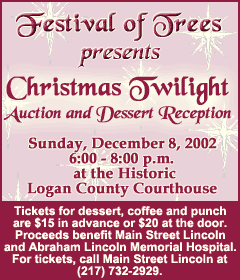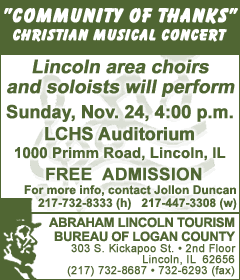|
Features,
Animals for Adoption,
Out and About,
Calendar
Travel News Elsewhere (fresh
daily from the Web)
Home and Garden News Elsewhere
(fresh daily from the Web)
|
|
Features
|
|
Tips for a
bright, safe
holiday lighting season
[NOV.
27, 2002]
URBANA — Holiday lighting
has always been an enjoyable way to celebrate the season and
beautify your home. If you’re planning a holiday lighting display,
the Safe Electricity public awareness program reminds you to avoid
potential safety hazards as you place holiday lights.
|
|
"Lights on a tree or other places add
so much to the festivity of the season, but they need to be checked
and used properly," says Molly Hall, director of the Safe
Electricity program. "We encourage everyone to take a few extra
minutes to avoid the risk of electric shock or fire."
Keep these tips in mind when decorating
with lights:
• Use only lights that have been safety tested and approved by
Underwriters Laboratory. Look for the UL label on the box and on
each string.
• If you use a fresh-cut tree,
frequently water it and place it away from heat sources, such as
heat registers, fireplaces, radiators and televisions.
• Before plugging in the lights, check
each string for broken sockets, frayed cords or faulty plugs.
Replace damaged strings.
•Make sure extension cords are in good
condition. Use only UL-approved cords that are rated to carry the
electrical load you will connect to them.
•Keep electric cords away of
high-traffic areas. Don’t stretch them across a room where people
can trip over them; likewise, don’t hide them under rugs or carpets.
•Always unplug lights before going to
bed or leaving your home.
•When decorating outdoors, use only
lights and cords rated for outdoor use. Do not lay cords across
sidewalks, decks or other walkways. Cords should be plugged into
outlets equipped with ground fault circuit interrupters — GFCIs. Use
a portable GFCI if your outdoor outlets don’t have them.
•Do not attach cords or lights to metal
objects.

[to top of second
column in this article]
|

"Checking the condition of electrical
cords is very important. A frayed or cracked cord could cause a
shock or fire," said Hall. "Likewise, an overloaded extension cord
poses a fire hazard."
Whether decorating for the holidays or
using extension cords in general, read the label on both the cord
and the appliances that are plugged into it to make sure the cord
can handle the load. If it can’t, change to a higher-rated cord or
unplug some appliances.
While some people may use an extension
cord to free outlet space over the holidays, remember that extension
cords are meant for temporary, not permanent, use.
Safe Electricity is a statewide
electrical safety public awareness program. The program was created
by a coalition of nearly three dozen organizations, including the
University of Illinois, rural electric cooperatives, and
investor-owned electric utilities from throughout the state. All are
members of the Illinois Electric Council, a not-for-profit
organization dedicated to promoting electric safety and efficiency.
Everyone is
urged to heed the safety tips presented in Safe Electricity public
service announcements and to visit
www.SafeElectricity.org
to learn more about being safe around electricity and related
equipment.
[U of I news release] |
|
|
Preparing for holiday
cooking
|
|
|
Check turkey cooking times
[NOV.
22, 2002]
A few years ago, the Food
Safety and Inspection Service, an agency with the United States
Department of Agriculture, released new cooking times for turkey.
According to Jananne Finck, nutrition and wellness educator with the
University of Illinois Extension in Springfield, turkey is cooking
faster than the old USDA cooking charts recommended. If you follow
those older charts, chances are your turkey will be ready sooner
than you might expect.
|
|
The best way to test for doneness is to
use a meat thermometer. The turkey is done when the thermometer
reaches a minimum of 180 F when placed in the innermost part of the
thigh. Be careful to insert in the fleshy part of the bird and avoid
touching a bone.
If the turkey has a "pop-up"
temperature indicator, it is also recommended that a food
thermometer be used to test in several places, including the
innermost part of the thigh and the center of the stuffing, if the
bird is stuffed.
Temperature recommended for roasting
whole turkey is 325 F. Preheating the oven is not necessary. Place
the turkey on a rack in a roasting pan before baking.
Cooking time for an unstuffed bird
weighing 8 to 12 pounds is 2 3/4 to 3 hours. Times for an unstuffed
12- to 14-pound turkey is 3 to 3 3/4 hours. For an unstuffed bird 14
to 18 pounds, roast 3 3/4 to 4 1/4 hours. An 18- to 20-pound turkey
needs 4 1/4 to 4 1/2 hours. Turkeys weighing 20 to 24 pounds are
estimated to take 4 1/2 to 5 hours.

[to top of second column in this article] |

For stuffed turkeys, the times are
longer. Turkeys weighing 8 to 12 pounds require 3 to 3 1/2 hours.
For a stuffed turkey weighing 12 to 14 pounds, roast 3 1/2 to 4
hours. For a stuffed bird weighing 14 to 18 pounds, roast 4 to 4 1/4
hours.
When cooking only a turkey breast, the
internal temperature should reach 170 F. Use a food thermometer to
check that stuffing has reached 165 F.
For more
information on cooking turkeys, contact your local University of
Illinois Extension office or visit
http://www.fsis.usda.gov/oa/
pubs/consumerpubs.htm.
[U of I Extension news release]
|
|
|
Low-fat stuffing for
Thanksgiving
[NOV.
22, 2002]
If lowering fat is a concern
for those wanting to serve traditional Thanksgiving foods, consider
preparing a low-fat stuffing this November. According to Jananne
Finck, nutrition and wellness educator with the University of
Illinois Extension in Springfield, standard stuffing can be high in
fat, sodium and calories.
|
|
The United States Department of
Agriculture has developed a healthier version of stuffing that saves
calories, fat grams and sodium. By cutting added fat, baking
separately from the bird and using spices to compensate for the
low-cal chicken broth, you can have a healthy holiday stuffing.
The stuffing recipe given may be
doubled for a larger crowd.
Savvy
stuffing
1 cup chopped celery
1/2 cup chopped onion
1 tablespoon margarine
8 cups soft bread cubes
1/2 teaspoon poultry seasoning
1/8 teaspoon pepper
1/8 teaspoon thyme leaves
3/4 cup chicken broth, low-sodium or
no-added-salt

[to top of second column in this article] |

1. Preheat oven to 350 degrees F.
2. Cook onions and celery in margarine
until tender. Remove from heat.
3. Mix in bread cubes, seasonings and
broth.
4. Place in greased 8-by-8-inch baking
dish.
5. Cover and bake one hour.
Yield: nine servings, about one-half
cup each
Nutrient analysis per serving: 108
calories, 3 grams fat, 3 grams protein, 18 grams carbohydrate, 1
gram saturated fat, 2 milligrams cholesterol and 208 milligrams
sodium
Exchanges:
one bread-starch, one-half vegetable, one-half fat
[U of I Extension news release]
|
|
|
Crowd-pleasing pumpkin pie
[NOV.
22, 2002]
Pumpkin pie is a
Thanksgiving holiday favorite with many American families. According
to Jananne Finck, nutrition and wellness educator with University of
Illinois Extension in Springfield, this holiday tradition may be
altered to save calories and fat.
|
|
This crowd-pleasing pumpkin pie recipe
has a savings of calories, fat grams and milligrams of cholesterol.
There’s less fat in the crust and less sugar in the filling to make
it a lower-calorie treat. Evaporated skim milk and two egg whites
substitute for whole milk and one egg to reduce calories and fat
even more.
If two tablespoons of light whipped
topping is served, this will add about five calories and 1 gram of
fat per serving.
Pumpkin
pie
Pastry
for 9-inch pie:
1 cup flour
1/4 teaspoon salt
1/4 cup margarine
2 tablespoons water
Filling
for 9-inch pie:
16 ounces pumpkin
12 fluid ounces evaporated skim milk
1 large egg, beaten
2 large egg whites
1/4 cup sugar
1/4 cup brown sugar
2 tablespoons flour
2 teaspoons pumpkin pie spice
1/4 teaspoon salt

[to top of second column in this article] |

1. Preheat oven to 375 degrees F.
2. Mix flour and salt. Mix in margarine
until dough forms pea-sized balls.
3. Add water; mix until just moistened.
Roll out dough on lightly floured surface. Line 9-inch pie pan with
pastry.
4. Mix filling ingredients well; pour
into shell.
5. Bake one hour or until knife put in
center comes out clean.
Yield: one 9-inch pie, nine servings
Nutrient analysis per serving: 210
calories, 7 grams protein, 33 grams carbohydrate, 6 grams fat, 1
gram saturated fat, 25 milligram cholesterol, 381 milligram sodium
Exchanges: 1
1/2 bread-starch, one-half milk, one fat.
[U of I Extension news release]
|
|
|
Low-fat turkey talk
[NOV.
22, 2002]
Yes, the holiday bird can be
a tasty low-fat entree for many to enjoy. According to Jananne Finck,
nutrition and wellness educator with University of Illinois
Extension in Springfield, the United States Department of
Agriculture forwards the following hints to lower the fat in turkey:
|
|
• Pre-basted turkeys are
high in fat. Buy a regular bird, if possible.
• Baste with broth instead
of greasy drippings.
• To keep turkey fat out
of the dressing, bake it separately in a lightly greased pan.
•
Eat less skin. Three ounces of light
turkey meat with skin have 7 grams of fat; without skin, 3 grams of
fat. Three ounces of dark meat with and without skin have 10 and 6
grams of fat.
[U of I Extension news release] |

|
|
|
Let’s talk turkey -- safe
turkey
[NOV. 1, 2002]
|
|
Food
thermometer essential
Cooking a stuffed turkey is riskier
than cooking one not stuffed. Harmful bacteria can survive in
stuffing that has not reached the safe temperature of 165 F,
possibly resulting in foodborne illness. Therefore, it is essential
that you always use a food thermometer to check the temperature of
the stuffing. For safety and uniform doneness, cook stuffing
separately in a casserole.
Preparing
stuffing safely
The ingredients for the stuffing can be
prepared ahead of time. Keep wet and dry ingredients separated;
chill. Mix wet and dry ingredients just before putting stuffing into
a casserole or filling the turkey cavity. The stuffing should be
moist, not dry, since heat destroys bacteria more rapidly in a moist
environment.
Cooking
stuffing safely
The safest way to cook stuffing is in a
casserole in a 325 degree oven. The internal temperature of the
stuffing must reach 165. If you choose to stuff your turkey, make
sure it is stuffed loosely. Cook the turkey immediately after
stuffing. Use a food thermometer to check the temperature in the
innermost part of the thigh and in the center of the stuffing. Even
if the innermost part of the thigh has reached a safe internal
temperature of 180, the center of the stuffing inside the turkey may
not have reached 165 and can cause foodborne illness. Continue to
cook the stuffed turkey until the stuffing has reached 165.
[to top of second
column in this article]
|
Standing time
For quality, you may choose to let the
turkey stand for 20 minutes to let juices set. If your turkey is
stuffed, the temperature of the stuffing will also continue to rise
during this time. Remove all the stuffing from the turkey
immediately after standing time.
Handling
leftovers safely
Refrigerate stuffing in shallow
containers. Use leftover stuffing within one to two days for best
quality.
A word
about buying stuffed turkeys
Buying stuffed turkeys without the USDA
or state mark of inspection is not recommended. Turkeys purchased
stuffed and frozen that have the USDA or state mark of inspection on
the packaging are safe because they have been processed under
controlled conditions. These turkeys should not be thawed before
cooking. Follow package directions for handling.
For
further information
Meat and poultry hot line:
1 (800) 535-4555, toll-free nationwide
1 (800) 256-7072, TTY
USDA Food Safety and Inspection Service
site:
www.fsis.usda.gov
[USDA "Food Safety Facts"
provided by the Logan County Health Department] |
|
|
Animals for Adoption
|
|
At Logan County Animal Control —
|
DOGS
Big to little, most of these dogs will make wonderful
lifelong companions when you take them home and provide solid,
steady training, grooming and general care. Get educated about what
you choose. If you give them the time and care they need, you will
be rewarded with much more than you gave them. They are
entertaining, fun, comforting, and will lift you up for days on end.
Be prepared to take the necessary time when you bring home a
puppy, kitten, dog, cat or any other pet, and you will be blessed.
[Logan County Animal Control is thankful for pet supplies donated by
individuals and Wal-Mart.]
|
|
Warden Sheila Farmer and her assistant, Polly Farmer,
look forward to assisting you.
|
|

[A friendly-faced 2-year-old male mixed Lab is seeking his
human soul mate.
He's not fixed, and he's good with other dogs.] |

[A purebred Doberman with a sweet disposition, this handsome 1½-year-old
male is good with children and other dogs. His ears are
cropped; he is not fixed.] |

[Yes, I have a purple tongue!
That's because I'm a black Labrador and chow chow mix. I'm
male and just 1 year old. I'm not fixed, and I would make a
great farm dog.] |

[Glory is looking for a quiet home where she
can get some TLC. She likes kids. An American bulldog, she is
7 years old and has not been fixed.] |
|
|
Ten reasons to adopt a shelter dog
1. I'll bring out your playful side!
2. I'll lend an ear to your troubles.
3. I'll keep you fit and trim.
4. We'll look out for each other.
5. We'll sniff out fun together!
6. I'll keep you right on schedule.
7. I'll love you with all my heart.
8. We'll have a tail-waggin' good time!
9. We'll snuggle on a quiet evening.
10. We'll be best friends always.
|
|
|
CATS
|
|
[Logan County Animal Control is thankful for pet supplies
donated by individuals and Wal-Mart.] |
|
Warden Sheila Farmer and her assistant, Polly Farmer, look
forward to assisting you. |
In the cat section there are a number of wonderful cats to
choose from
in a variety of colors and sizes.
Farm cats available for free!
|

[This lovely lady with green eyes is Bailey. She is 3 years
old and has been spayed and declawed. She would love a new
home full of love.] |

[This soft-faced 1-year-old male kitty needs a cat lover's
care. He has not been fixed but has been declawed.] |
|
|
These animals and
more are available to good homes from the Logan County Animal
Control at 1515 N. Kickapoo, phone 735-3232.
Fees for animal
adoption: dogs, $60/male, $65/female; cats, $35/male, $44/female.
The fees include neutering and spaying.
Logan County Animal Control's hours of operation:
Sunday
– closed
Monday –
8 a.m. - 5 p.m.
Tuesday –
8 a.m. - 5 p.m.
Wednesday –
8 a.m. - 5 p.m.
Thursday –
8 a.m. - 5 p.m.
Friday –
8 a.m. - 3 p.m.
Saturday –
closed
Warden: Sheila Farmer
Assistant: Polly Farmer
In-house veterinarian: Dr. Lester Thomson
|
|
|
|
 |
|
From
the Department of Natural Resources
Illinois outdoor news
[NOV. 23, 2002]
Hunters in Illinois harvested a
preliminary total of 1,489 wild turkeys during the 2002 fall firearm
turkey season, Oct. 19-27. Among counties with the top county
harvest totals were Jo Daviess (157), Pope (73), Marion (70), Union
(62) and Fulton (57). The fall firearm turkey harvest this year
compared with a statewide harvest total of 1,415 in 2001. A total of
43 counties were open for firearm turkey hunting during the 2002
fall season.
|
|
* * *
Illinois recently reported its first
confirmed case of chronic wasting disease, when a tissue sample
taken from an adult female deer in Winnebago County tested positive
for CWD. Hunters and others looking for what they need to know if
they are hunting in Illinois or out of state, for general
information about the disease, and for new information as it becomes
available should check
http://dnr.state.il.us/pubaffairs/2002/CWD.htm.
* * *
The Carlyle Lake Waterfowlers
Association was honored recently as recipient of the U.S. Fish and
Wildlife Service’s Canvasback Award for its efforts on behalf of the
Carlyle Lake Wildlife Management Area in Fayette County. Owned by
the U.S. Army Corps of Engineers and managed by the Illinois
Department of Natural Resources, the 9,486-acre complex of
bottomland wetlands, timber and crop lands provides valuable habitat
for a wide variety of wildlife. Due to a major levee failure,
management of vegetation and water levels was difficult at the
CLWMA’s Subimpoundment 3. The Carlyle Lake Waterfowlers Association
provided heavy equipment and more than 1,000 hours of manpower to
repair broken levees, allowing the IDNR to again regulate water
levels at the 312-acre unit, benefiting local and migratory wildlife
and waterfowl while enhancing hunting opportunities.
The IDNR nominated the association for
the Canvasback Award, which was presented by the USFWS and the
Service’s Upper Mississippi River and Great Lakes Region Joint
Venture Management Board.
The Carlyle Lake Waterfowlers
Association has been active in issues concerning the Carlyle Lake
Wildlife Management Area since the early 1980s.
* * *

Avery Outdoors presents the 7th annual
Avery International Goose Calling Invitational and Waterfowl Hunt in
Marion on Jan. 3-5. It includes the world’s biggest calling event
with the sport’s richest prize purse — $12,500 — on Saturday night,
Jan. 4. The contest and hunt, coordinated by the Illinois Department
of Natural Resources, the Illinois Conservation Foundation and the
Williamson County Tourism Bureau, will feature world-class goose
callers, including Kelley Powers, Brandon Fletcher, Troy Dishner,
Sean Mann, Kevin Popo, Allan Stanley, Mark Carey, Richie McKnight
and John Pasoni.
It’s also the only event of its kind
that combines a championship goose calling contest with an actual
hunt, all designed to raise money for future youth waterfowl hunting
events in Illinois. For only $750, hunters get private
accommodations for two nights, breakfast Saturday and Sunday, a
Friday night dinner and pairings party, two days of waterfowl
hunting (including pit fees and Hevi-Shot ammo) with participating
goose callers, and a commemorative gift. Proceeds from the event
will benefit the Illinois Conservation Foundation, an IRS 501 (c)(3)
approved organization, which earmarks the money to support youth
waterfowl hunting opportunities and youth education programs in
southern Illinois. A portion of the cost of each participant’s hunt
is deductible for federal income tax purposes.
Each hunter’s registration is an
important investment in the future of outdoor recreation and youth
education. For more information, call the Illinois Department of
Natural Resources, Special Events, (217) 785-8955, or send an e-mail
note to
events@dnrmail.state.il.us.
* * *

[to top of second
column in this article]
|

Would your students like to grow plants
and raise insects in your classroom? Would they like to become part
of a statewide biological control program to control the invasive
purple loosestrife? If so, take part in a workshop, "Biodiversity,
Wetlands and Biological Control — Purple Loosestrife: A Case Study,"
sponsored by the Illinois Natural History Survey and IDNR/ENTICE.
Two workshops are being offered for the year 2003: Jan. 25 at Sand
Ridge Nature Center in South Holland (Cook County) and Feb. 1 at
Volo Bog State Natural Area near McHenry. The workshops are free,
CPUDs are offered, and you receive all the items you need to
complete the project in the classroom. To register and for more
information, contact Susan Post at Illinois Natural History Survey
at (217) 333-4322 or
spost@mail.inhs.uiuc.edu.
The purple loosestrife study program
developed by the Illinois Natural History Survey’s Dr. Michael R.
Jeffords and Dr. Robert N. Wiedenmann has received national
recognition with its selection for a 2002 Celebration of Excellence
award by the University Continuing Education Association. The
national UCEA award, designed to encourage innovation and
distinction in continuing education, was presented at the
organization’s annual conference in Minneapolis last month. The
purple loosestrife program presents teachers and other interested
parties with options for combating invasive species, utilizing
natural controls. An online course, available to middle and high
school teachers, is a collaboration of the University of Illinois
and the Champaign-based Illinois Natural History Survey, a division
of the Illinois Department of Natural Resources. For more
information on the program, contact the INHS at (217) 333-6830.
* * *
Reminder: The Illinois Department of
Natural Resources will conduct blaster licensure and certification
examinations on Feb. 21, 2003, and Oct. 23, 2003, at Ramada Limited,
3281 Northfield Drive, Springfield. Training will be provided at the
testing location prior to each exam. All individuals whose duties
include the direct supervision of blasting operations at surface
coal and non-coal mining operations are required to be licensed or
certified. Applications must be received before examination. For an
application form or to schedule a training class, contact IDNR’s
Blasting and Explosives Division, One Natural Resources Way,
Springfield, IL 62702-1271. Individuals in need of training
modifications to enable their participation should notify the
Blasting and Explosives Division at (217) 782-9976 or TTY (217)
524-4626.
***

Applications are being accepted for the
Small Project Program of the Wildlife Preservation Fund,
administered through the IDNR Office of Resource Conservation,
Division of Resource Protection and Stewardship. This program is
funded through a voluntary checkoff designation to the Wildlife
Preservation Fund on the state income tax form.
Small Project Program proposals may
address many types of projects, including management, site
inventories or education. Examples of past projects include wildlife
habitat improvement, species enhancement, education and research
projects throughout the state, focusing on species ranging from
birds to turtles, and habitat ranging from forests to prairies.
Individual proposals are eligible for up to $1,000 from the Wildlife
Preservation Fund. The grants would be effective July 1, 2003 - June
30, 2004.
The Illinois Wildlife Preservation Fund
Small Project Program packet for 2004 includes a program
explanation, instructions for completing the application form and an
application form. The packet is available on request; phone (217)
785-8774 or e-mail
SpecialFunds@dnrmail.state.il.us. You will need to provide the
following information: name, affiliation, address and telephone
number. Applications will be accepted through April 15, 2003.
[Illinois
Department of Natural Resources
press release] |
|
Back to top |
News |
Sports | Business
| Rural Review |
Teaching & Learning |
Home and Family |
Tourism |
Obituaries
Community |
Perspectives |
Law & Courts |
Leisure Time |
Spiritual Life |
Health & Fitness |
Calendar
Letters to the Editor
|
|

